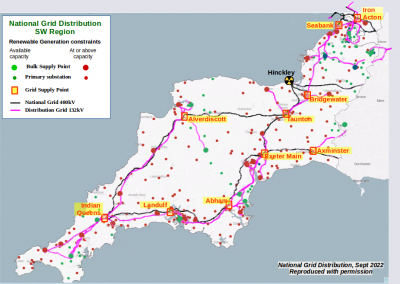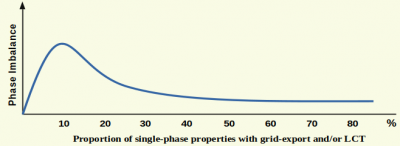Xlinks and other strategies to achieve nett zero
Thanks for that link @jeff
I need to write to Ofgem about their current appraisal. It's got tied up in an attempt to resolve the historical CfD (Contracts for Difference) pricing which plagues the electricity wholesale market. I can see why respondents to Ofgem's consultations are concerned to see a financial resolution to this... because it's an important way by which profits are made in the UK energy market. That suggests to me that the majority of consultees were active participants in that market. 😣
The present proposal is based on the idea that the nodes would be based around the GSP transformers... the ones that interface between the distribution grid (132kV & below) and the national transmission grid. For clarity, here's an updated version of my earlier map, onto which I've inserted a layer showing the ten GSPs in my own SW Region:
This graphic is a composite based on the Constraints Map published by NG-Distribution. Some details have been removed or obscured for national security reasons.
SW England region is a good choice for demonstrating this point. It's already approaching an average balance of supply & demand over the year, so it's a fair representation of where the country must head in order to achieve Net Zero by 2050.
It's already obvious that the majority of the Primary and BSP transformers are operating at or above capacity to accept further renewable generation. To alleviate this, the financial incentive to consume/store electricity needs to operate below the GSP transformer level.
Save energy... recycle electrons!
@transparent 32.7% of electricity is used domestically nationally.
Just curious.
What are your thoughts on non domestic users in the South West?
Is there any data on who is using the electricity on each of the transformers you mention in the SW? Even if it is estimated?
I hadn't realised it was 32.7% domestic usage. That's a useful statistic... although I suspect that the non-domestic use has a significant proportion of customers who are mega-users such as steel-works, and glass/pottery factories.
There is no such information available from the NG-Dist data I have. Individual customers can't be identified as such. I would have to first decide on a locality of interest, and then drill down to look at the current flows. But I'm not sure it's worth my time to investigate how much electricity passes through the Primary Substation next to Port Talbot steel works! We can already guess that answer.
BTW I have access to all four NG-Dist regions' data, not just SW. So if I wanted spend days writing scripts to pull data into spreadsheets, I'm sure I could discover all sorts of useful comparisons across the country. I'm obviously interested in findings that could take the country forward in the way we move to widespread renewable generation. So it's likely I'm viewing this treasure-trove of data differently to the way in which the energy-industry envisage using it.
In a nutshell I think the country needs to be attracting business users to locate themselves in areas where there is more abundant green electricity generation.
The over-supply of electricity in locations at the extremities of the original National Grid should be an incentive for commercial/technological regeneration, rather than seen as a problem which requires massive/costly infrastructure upgrades.
Take a step back, and ignore all the complex formulae currently in use to pay NG-Transmission and the DNOs for UoS (Use of Service):
If we 'grew' GB's renewable electricity network based on the locations and time-frames when it could be generated, what would the resulting grid look like?
- Would it be like a honeycomb of hexagons which interlink the locations of supply and demand?
- Or would it look like a copse of trees in which multiple roots gather electricity and send it through just a few hundred tree-trunks to be distributed by the branches?
Whatever that 'biological' pattern looks like, then that's likely to be the most effective and resilient way in which our grid should evolve.
Save energy... recycle electrons!
Table 5.2
Worth bearing in mind they have included 8% for losses generally in one of the non domestic buckets as an example. So care needs to be taken depending on how the figures are used i think.
Anyway might be some stuff you find useful.
Interesting Iron and Steel is 1% probably as we have lost a lot of that industry and a lot is yet to convert to electricity.
I agree encouraging business and people to areas with excess electricity sounds like a great thing.
Thanks for that link @jeff
Yes, they've assigned 8% for losses in the part of the graphic which is non-domestic because it occurs before the meter.
But the losses which are of most concern are those of phase-imbalance. By definition that is due to usage or export from premises that are single-phase... which includes 99% of our housing.
Let's imagine a local substation supplying an estate with 150 houses, a primary school, a shop and a community hall. The first home to install PV panels with a grid-tied inverter will cause grid imbalance. Three homes with PV might restore balance, but only if they are split between the three phases and on the same transformer feed. In practice no account is taken of this. Few domestic properties even have any record of which phase supplies them.
Imbalance will again occur with the first house to install an EV charger or a heat-pump. That's why both of these require LCT (Low Carbon Technology) approval from the DNO.
In broad terms phase imbalance increases until that technology is installed in about 10% of properties:
Phase imbalance can't be entirely eradicated because there are personal choices being made by householders wrt their decision to buy into each type of technology and when to run it.
But it's obvious that we must get adoption of such technology beyond the 10% region of the graph. Unfortunately, that's roughly the current uptake of grid-tied PV panels. 😣
Save energy... recycle electrons!
Unfortunately @jeff, long before Xlinks is active, it will be Hinkley C which will have dramatically reduced the carbon footprint of SW and S Wales regions.
Save energy... recycle electrons!
Posted by: @transparentUnfortunately @jeff, long before Xlinks is active, it will be Hinkley C which will have dramatically reduced the carbon footprint of SW and S Wales regions.
And further plants of some sort are likely (?) in the country given current Labour and Conservatives and Liberal Democrat policy is pro Nuclear for energy security.
The main political parties are pro-nuclear because they're not being presented with alternative viable options which combine renewables and storage.
Every time we're about to crack that problem, demand rises instead (EVs and Heat Pumps).
If only we could find someone who's in the same constituency as the MP running BEIS 😉
Save energy... recycle electrons!
Posted by: @transparentThe main political parties are pro-nuclear because they're not being presented with alternative viable options which combine renewables and storage.
Every time we're about to crack that problem, demand rises instead (EVs and Heat Pumps).
If only we could find someone who's in the same constituency as the MP running BEIS 😉
I am sure the government is inundated with groups telling them about a "viable" option...
Wading through the noise to get a pragmatic, realistic, deliverable and politically acceptable short, medium and longer term vision and plan can't be easy. There is an awful lot of content out there already.
I am very positive about us getting off fossil fuels, am sure we will find a pragmatic way through it. It won't be a perfect ground up solution and it will take time.
Am particularly impressed with the speed of off shore wind turbine deployment planned and in progress. Lot's of other positive things going on.
If we ever send Grant anything or speak to him, it needs to something he can realistically follow through on. That would be my first test personally.
- 26 Forums
- 2,367 Topics
- 53.7 K Posts
- 98 Online
- 6,042 Members
Join Us!
Worth Watching
Latest Posts
-

RE: Connecting Growatt SPH5000 over wired ethernet rather than wireless
@z8lccda, you’ve just described my setup - Growatt SPH5...
By Majordennisbloodnok , 6 hours ago
-
Data Accuracy Problem: Daikin 8kW Heat Pump's Onecta App vs MMI Power Consumption
Good Evening. Has anyone found the following when usi...
By Nursethescreens , 8 hours ago
-
RE: Help needed with Grant Aerona 3 issues
First time posting so bear with me. Some bits that have...
By Adamp , 11 hours ago
-
RE: Mitsu PUHZ-SW120YHA + EHSC-VM20Uk - Performance
All understood. Obviously its a bit house de...
By JamesPa , 12 hours ago
-
RE: Water Hammer After Heat Pump Install
From OPs description I had the impression (quite possib...
By JamesPa , 14 hours ago
-
RE: Who's your electricity provider and what's your tariff?
@majordennisbloodnok This may be a better thread to ...
By Batpred , 1 day ago
-

RE: Best Heat Pump Brand in the UK
Last Call to Vote & Win! Haven't voted for your Hea...
By Mars , 2 days ago
-

RE: Solis S6-EH1P8K-L-PLUS – Why I Chose It and What I’ve Learned So Far
Interesting question. To be frank, since I have no inte...
By Majordennisbloodnok , 2 days ago
-
RE: Changing from 4-port buffer to volumizer
@andy1618 see the very sage advice from @editor above. ...
By JamesPa , 2 days ago
-
RE: New Fogstar 15.5kWh upright solution
The video shows the JK balancer, but the connection of ...
By Batpred , 2 days ago
-
RE: Ecodan unable to hit legionella target temp - what's the consensus?
@9jwr9 Hi, yes this is the issue with every (stand alon...
By ASHP-BOBBA , 2 days ago
-
RE: Help me keep the faith with my air source heat pump installation
@adamk FWIW I managed unintentionally to 'coax' mine in...
By JamesPa , 2 days ago
-
RE: Octopus Cosy Heat Pump Owners & Discussion Thread
You are in essence right. Adia only works with selecte...
By JamesPa , 2 days ago
-

No, you haven’t missed out, @batpred. This thread’ll st...
By Majordennisbloodnok , 2 days ago
-

RE: Tesla Powerwall – More of a ‘Luxury’ Than an ROI Winner!
Also, though they weren’t prepared to match the price t...
By Toodles , 3 days ago
-
RE: How long will your energy contract last?
My INTELLI-FIX-12M-25-08-29 has less than 12 months to ...
By Batpred , 3 days ago
-

RE: GivEnergy 2025 forthcoming batteries and inverters
Then, perhaps @toodles , you should've made a submissio...
By Transparent , 3 days ago
-
RE: Balancing financial efficiency and comfort using the Octopus Cosy tariff
I am wondering if anyone with an EV could find the 7p/k...
By Batpred , 3 days ago
-
Possibly, but it would also reduce DeltaT across the em...
By JamesPa , 3 days ago







